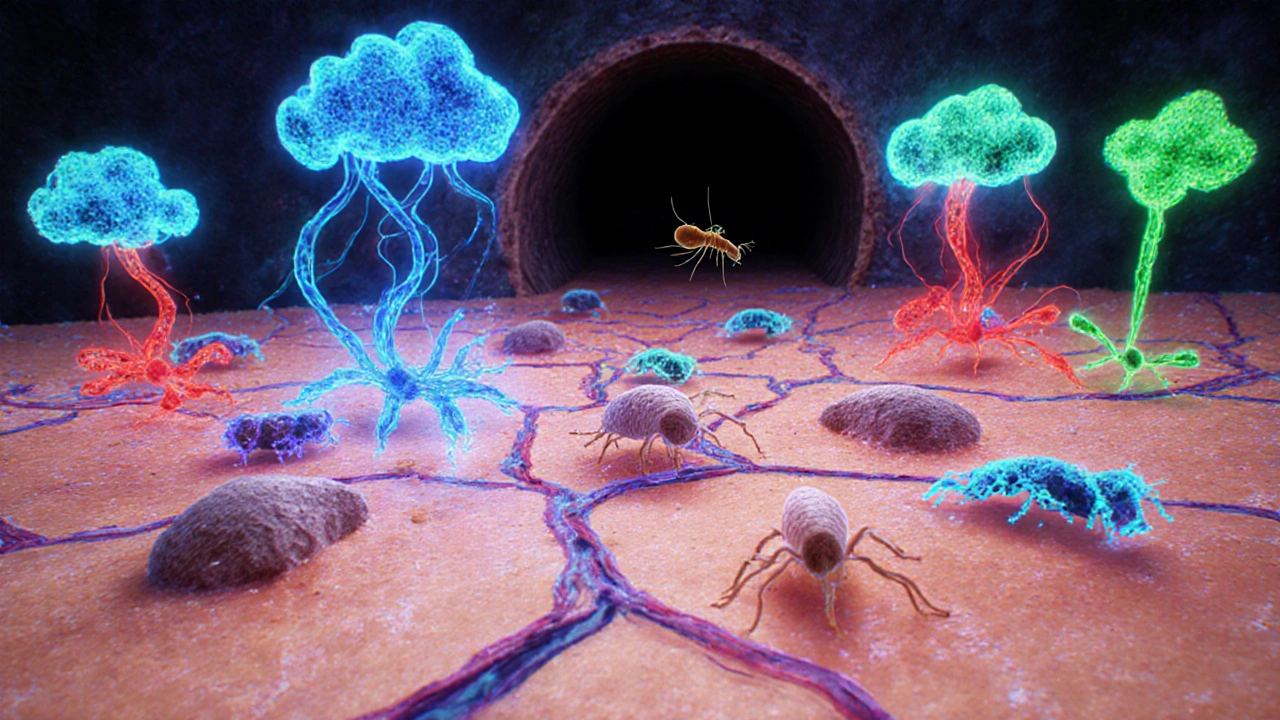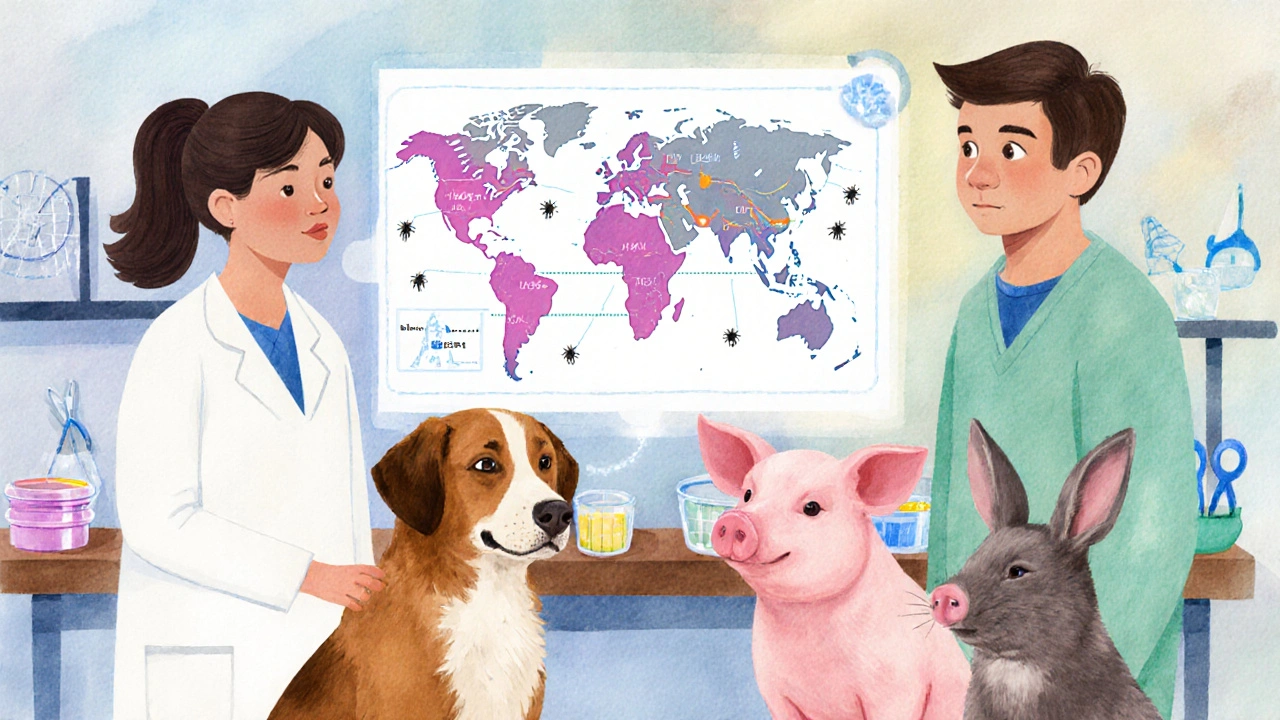Scabies Susceptibility Risk Calculator
Genetic and Environmental Risk Factors
This tool estimates your relative risk of scabies infestation based on genetic predisposition and lifestyle factors.
Your Risk Assessment
Ever wondered why some people or animals get scabies while others seem untouched? The answer often lies in our DNA. In this article we unpack how genetic make‑up shapes the risk of Sarcoptes scabiei infestation, the mite that causes scabies, and what that means for treatment and prevention.
Key Takeaways
- Specific genes-especially those governing skin barrier and immune response-can increase or decrease scabies risk.
- Human studies point to variants in MHC class II and the filaggrin gene (FLG) as major players.
- Animal models (dogs, pigs, rabbits) reveal similar pathways, supporting a cross‑species genetic component.
- Understanding genetic susceptibility helps clinicians tailor prophylaxis and informs vaccine research.
- Future work hinges on larger genome‑wide association studies (GWAS) and functional validation.
What is Sarcoptes scabiei?
Sarcoptes scabiei is a tiny, burrowing mite that lives in the upper layer of skin. It spreads through close skin‑to‑skin contact or shared bedding, causing intense itching, rash, and secondary infection. While the clinical picture looks similar across humans and animals, the underlying host response can vary widely.
Genetics 101: Why DNA Matters for Infection
Every individual carries a unique set of genetic variants-small changes in the DNA sequence that can alter how proteins function. When a pathogen like S. scabiei invades, these protein differences dictate how quickly the immune system spots the intruder, how strong the inflammatory signal is, and how well the skin barrier holds together.

Key Genetic Markers Linked to Scabies Susceptibility
Research over the past decade has spotlighted a handful of genes that repeatedly show up in high‑risk groups.
- Filaggrin (FLG) loss‑of‑function variants: FLG is essential for skin barrier integrity. People with FLG mutations have a "leaky" barrier, letting mites burrow more easily. A 2022 Australian cohort found a 1.8‑fold increase in scabies prevalence among FLG‑deficient individuals.
- MHC class II (HLA‑DRB1, HLA‑DQB1) alleles: These molecules present mite antigens to T cells. Certain alleles (e.g., HLA‑DRB1*04) correlate with a heightened Th2 response, which fuels itching but doesn’t clear the infestation efficiently.
- Cytokine gene polymorphisms (IL‑4, IL‑13, IFN‑γ): Variants that tilt the immune balance toward a Th2‑dominant profile increase susceptibility, while IFN‑γ promoting alleles offer some protection.
- Toll‑like receptor (TLR) variants: TLR2 and TLR4 recognize mite‑derived molecules. Loss‑of‑function SNPs dampen early innate signaling, delaying mite detection.
- Skin‑related keratin genes (KRT1, KRT10): Mutations that affect keratin filament organization can weaken the stratum corneum, giving mites an easier path.
These findings come from case‑control studies, family‑based linkage analyses, and the first genome‑wide association studies (GWAS) conducted in 2021‑2024 across Europe, Asia, and Oceania.
Host Immune Pathways: From Genes to Action
When a mite tunnels into the skin, the body’s first line of defense involves pattern‑recognition receptors (PRRs) like TLRs. If the genetic make‑up compromises PRR signaling, the subsequent cascade-production of cytokines, recruitment of eosinophils, and activation of IgE‑mediated pathways-can become dysregulated.
In individuals with Th2‑biased genotypes (e.g., IL‑4Rα polymorphisms), the immune response leans heavily on IgE and eosinophils, producing the classic itching but failing to eradicate the mite. Conversely, a stronger IFN‑γ response (linked to certain HLA alleles) promotes a more effective cell‑mediated clearance.
Animal Models Illuminate Cross‑Species Genetics
Dogs, pigs, and rabbits serve as valuable models because they naturally contract scabies and share many of the same immune genes as humans.
| Species | Key Gene(s) | Effect on Susceptibility |
|---|---|---|
| Human | FLG, HLA‑DRB1, IL‑4 | Barrier loss + Th2 skew → higher risk |
| Dog | Canine DLA‑DRB1, KRT1 | Specific DLA alleles linked to severe mange |
| Pig | TLR2, IFNG | TLR2 deficiency leads to delayed mite clearance |
| Rabbit | FLG‑like gene, IL‑13 | Mutations increase burrowing depth of mites |
These parallels suggest that the same genetic pathways-skin barrier, antigen presentation, cytokine signaling-govern susceptibility across mammals.

Clinical Implications: From Diagnosis to Prevention
Knowing a patient’s genetic risk can refine several aspects of care:
- Risk stratification: Families with a history of FLG mutations might benefit from early skin‑barrier moisturizers during outbreaks.
- Targeted therapy: Patients with a Th2‑dominant genotype could respond better to anti‑IL‑4/IL‑13 biologics (e.g., dupilumab) when standard scabicidal agents fail.
- Public‑health screening: In high‑density settings (nursing homes, shelters), genetic screening isn’t practical yet, but awareness of genetic clusters can guide prophylactic ivermectin distribution.
Importantly, genetics is only one piece of the puzzle. Hygiene, crowding, and previous exposure still dominate outbreak dynamics.
Future Research Directions
While we have a growing list of susceptibility genes, several gaps remain:
- Large‑scale multi‑ethnic GWAS: Most current studies focus on European cohorts. Including African, Indigenous Australian, and Southeast Asian populations will uncover unique variants.
- Functional validation: CRISPR‑edited skin organoids can test how FLG loss directly affects mite colonisation.
- Gene‑environment interaction studies: Assess how factors like eczema, climate, and microbiome modulate genetic risk.
- Vaccine development: Identifying universally presented mite antigens via HLA binding predictions could speed a scabies vaccine.
- Precision prophylaxis: Tailoring ivermectin dosing based on metabolic gene variants (e.g., CYP3A4) to maximize efficacy and limit side effects.
These avenues promise a future where scabies management is as personalized as any other dermatologic condition.
Quick Reference Checklist for Clinicians
- Ask about family history of atopic dermatitis or eczema (possible FLG issues).
- Consider genetic testing for recurrent, treatment‑resistant scabies in high‑risk patients.
- Use moisturizers rich in ceramides for patients with suspected barrier defects.
- Keep an eye on emerging biologic options for Th2‑dominant cases.
- Educate patients that genetics increases risk but does not guarantee infestation.
Frequently Asked Questions
Can a DNA test predict who will get scabies?
Not yet. Current genetic markers only indicate a higher risk, not certainty. Testing is mostly limited to research settings.
Is scabies more common in people with eczema?
Yes. Eczema often involves FLG mutations, which weaken the skin barrier and make it easier for mites to burrow.
Do pets share the same susceptibility genes as humans?
While the exact genes differ, the pathways are similar-skin barrier, antigen presentation, and innate immune receptors all play roles in both humans and animals.
Should I get a genetic test if I’ve had scabies before?
Only if you have recurrent, hard‑to‑treat cases or a strong family history of atopic skin conditions. Discuss with a dermatologist or genetic counselor.
Are there any preventative measures based on genetics?
While no gene‑specific vaccine exists yet, improving skin barrier health (regular moisturizers) and avoiding close contact during outbreaks are the best universal strategies.
Understanding the genetics of scabies susceptibility gives us a clearer picture of why the same mite wreaks havoc on some hosts and not others. As research expands, the hope is to turn this knowledge into tailored prevention, smarter treatments, and eventually a vaccine that protects everyone-from humans to our furry companions.
